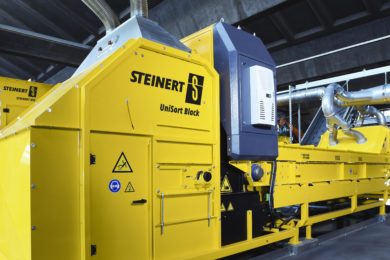Novo Resources Corp has announced that the company has completed encouraging gold processing trials at the Steinert Global testing facility in Perth, Australia. Recent tests of Steinert mechanical sorting equipment demonstrate recovery of fine gold nuggets as small as 0.4 mm, a significant step toward a potentially cost-effective “dry and chemical free” means of gold recovery.
Recent proprietary technological improvements in sensor sensitivity, image recognition ability and software development made by Steinert have been driven by the need to sort fine particles of metal such as copper from industrial waste, Steinert’s main business focus. Novo is working with Steinert to exploit this technology as a potential means of gold recovery.
This technology, using induction sensors as the primary means utilised to detect small gold particles, adds to Novo’s “palette” of potential processing solutions. Fine nugget sorting testwork complements Novo’s recent tests of other technologies including eddy current separation and X-ray transmission mechanical sorting of gold-bearing conglomerate. Novo envisions applying a combination of technologies to process its conglomeratic and lag gravel gold deposits that it is exploring across the Pilbara region, Australia, noting that Beatons Creek, in addition to coarse gold, has significant quantities of very fine gold amenable to conventional CIL gold processing.
Steinert has provided favorable initial guidance on expected productivities of sorting various size fractions of gold-bearing material utilising mechanical sorters. Productivity estimates include:
- Particle sizes 17-50 mm: approximately 280 t per hour
- Particle sizes 6-17 mm: approximately 90 t per hour
- Finer particle sizes including sub-mm: approximately 50 t per hour
The numbers above are estimated based on sorting a loosely packed mono-layer of material scattered across 70% of a 2 m wide conveyor belt moving at a speed of 2.8 m/sec. Sorting of fine material may benefit from use of thinner belts, 3 mm instead of 5 mm, which allows for a higher induction signal and is expected to further reduce the size of gold particles that can be detected.
Steinert has also provided encouraging mechanical sorting operating cost guidance. Typical operational cost of mechanical sorters is around US$1.00-$1.50 per tonne of feed processed at a belt coverage of 12%. A significant proportion of operating costs are associated with the cost of providing compressed air to the ejection valves. Mechanical sorters are typically used for upgrading feeds ahead of long-distance trucking to a plant or as pre-processing to upgrade material where processing plants are constrained for throughput. Each of these scenarios involve high ejection rates, often exceeding 50% of the total mass. In contrast to this traditional use, Novo’s intended application contemplates mechanical sorting as the primary sorting mechanism to separate gold particles and it is expected that less than 1% of material will require ejection at 70% belt coverage. Novo have been advised that processing cost could potentially be reduced under this scenario to as low as US$0.26 per tonne.
Novo envisions utilisation of mechanical sorting as a means of dry processing of Egina lag gravels and is making plans to field test this technology in 2020. These technological improvements in nugget detection have positive implications for gold capture at Novo’s Karratha gold project. Test work conducted on Karratha conglomerates by TOMRA, Sydney, Australia, in late 2018 and early 2019 clearly shows mechanical sorting of +6 mm gold-bearing rock is effective at capturing a significant percentage of gold, but a solution for the -6 mm fraction of crushed gold bearing conglomerates was not feasible at that time. It now appears a solution is possible.
“Technological improvements in mechanical sorting technology continue apace, with Australia’s dominant mechanical sorting companies, Steinert and TOMRA, each supported by strong and active research and development divisions. Both companies continue to strive for improved detection and ejection capabilities to advance commercial application of mechanical sorters in the resources sector.”
“Our recent tests on sortability of fine gold nuggets are very encouraging,” commented Rob Humphryson, CEO and Director of Novo. “As investors are aware, Novo is experimenting with a number of waterless, chemical free processing techniques to handle the unique nuggety gold in our Pilbara conglomerates and lag gravels. Tests over the past few months with Steinert mechanical sorters fitted with induction sensors have shown that we can now reliably identify gold particles orders of magnitude smaller than possible only a year ago. Early this year, we showed that sorting of gold-bearing rock material using TOMRA’s mechanical sorters utilising x-ray transmission is highly effective. More recent tests using Steinert eddy current separators also proved very promising. We are quickly developing a palette of processing techniques that can be potentially utilised to treat our various styles of mineralisation. Whilst we have been assured that a detected gold particle can be reliably ejected, field testing of these technologies in 2020 will be the next critical step to prove this technology and gain an operational understanding of productivities, costs and detection size limits.”










